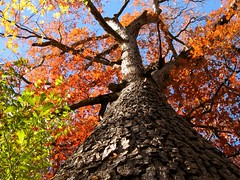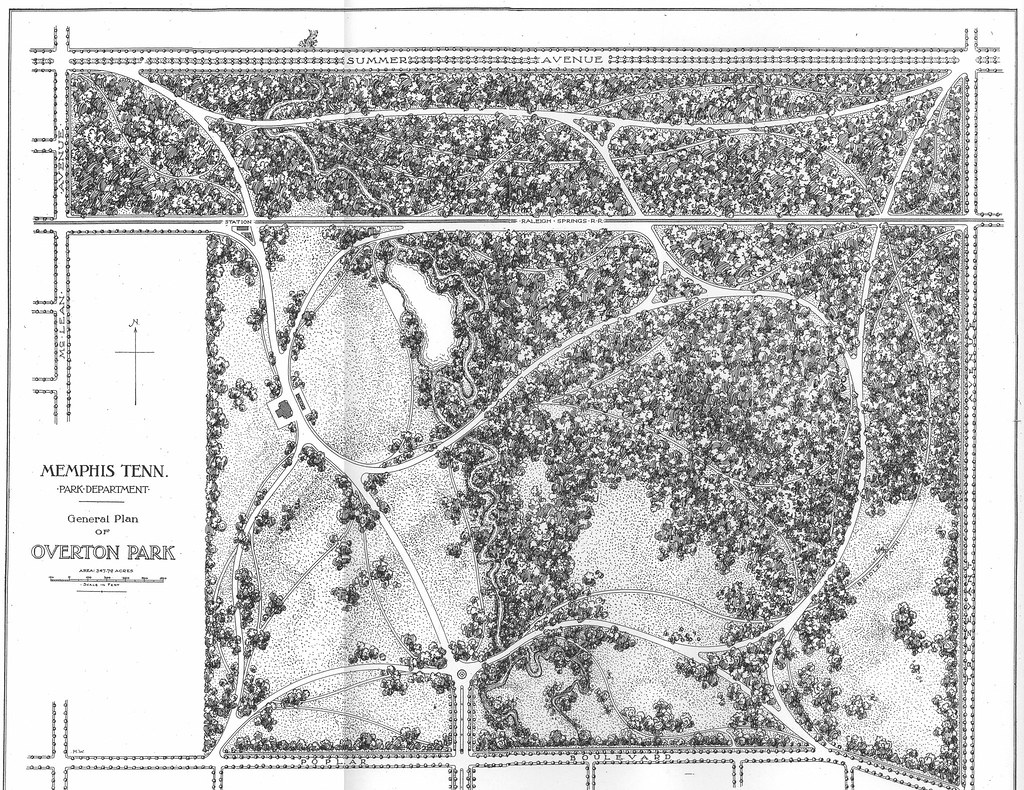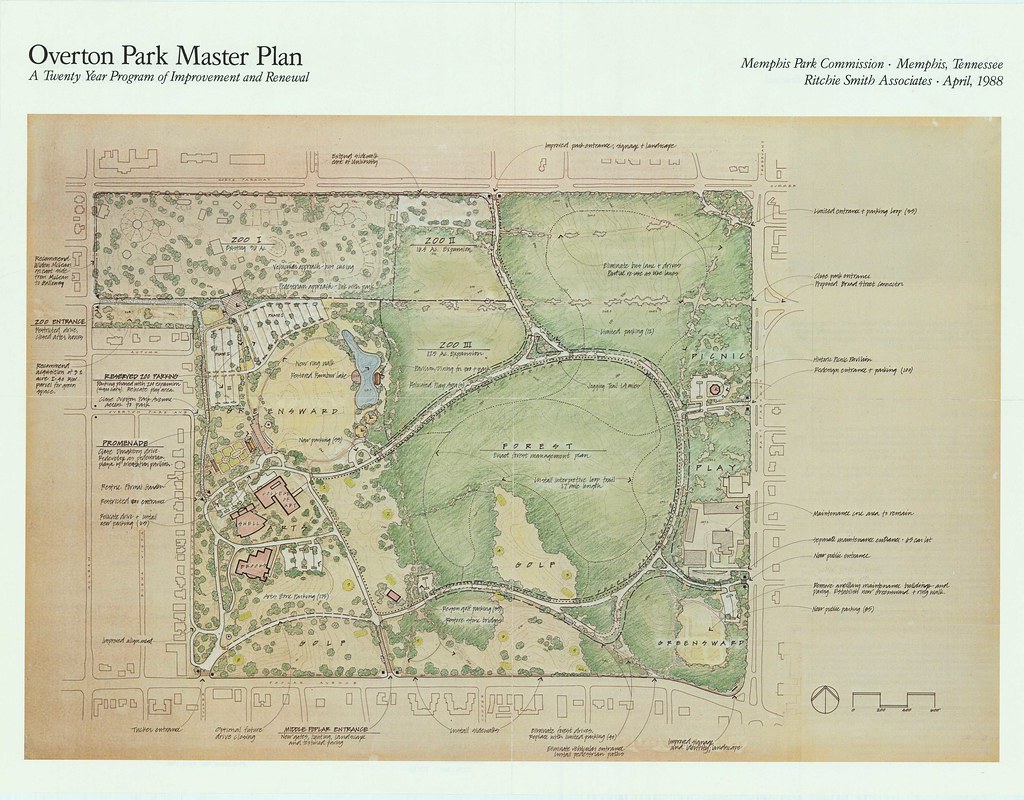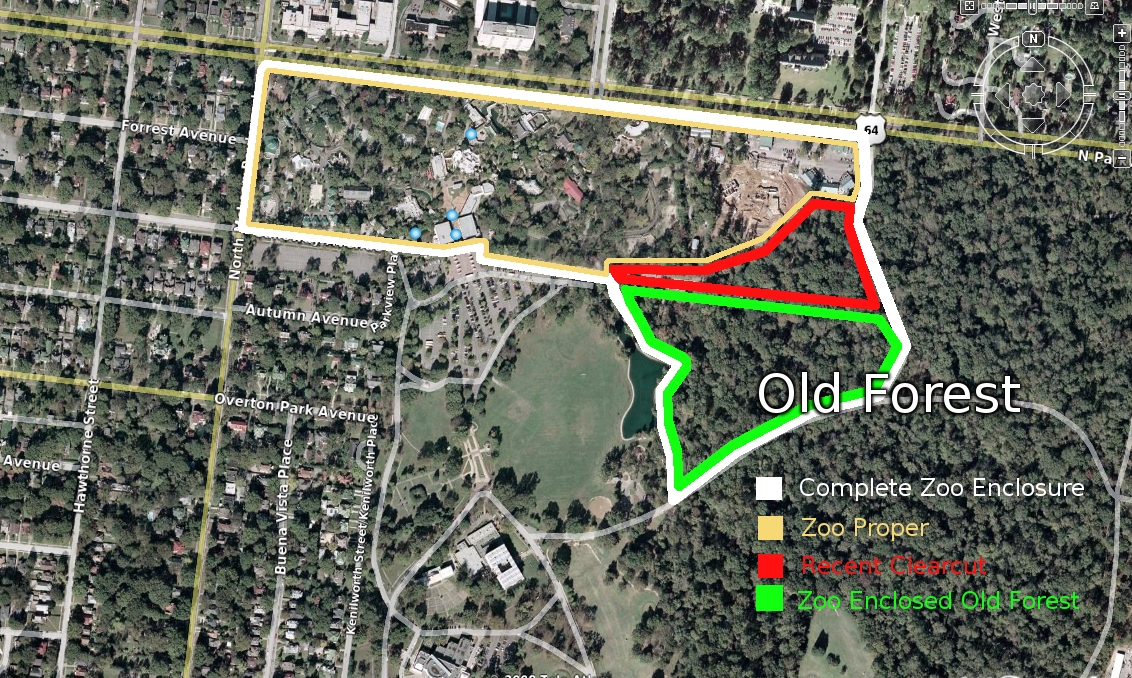LETTERS TO THE EDITOR
Monday, March 29, 2010 - Commercial Appeal
Old Forest needs legal shield
I was delighted to see Naomi Van Tol's March 19 Viewpoint guest column ("We deserve healthy forest, healthy zoo"), and I support completely the efforts of Citizens to Preserve Overton Park to enact the Old Forest State Natural Area bill to protect the Mid-South's last old-growth forest.
As an environmental lawyer, I am aware that Memphis is not exactly on the cutting edge of environmental conservation, with a few notable exceptions. One example of environmental stewardship in our city is the Greater Memphis Greenline, which is in the process of converting approximately 7 miles of the old CSX railroad right-of-way into the Shelby Forest Greenline, a multiuse recreational path and park running from Midtown Memphis to Shelby Farms Park. And, out in Fayette County, in 1995, activists worked with the state of Tennessee to afford protection to more than 2,000 acres of the headwaters of the Wolf River with the designation of the Ghost River State Natural Area.
The Old Forest State Natural Area bill is another great example of environmental protection at work in the Memphis area. The Old Forest is certainly worthy of legal protection.
It is time for the Memphis Zoo to step up and support this legislation. Both the zoo and the Old Forest benefited from the grass-roots efforts of concerned citizens in the early 1970s, when CPOP successfully blocked a proposed extension of Interstate 40 through Overton Park. I hope the Memphis Zoo can recognize the value of the Old Forest by rising to this challenge to further its mission of preservation by working with CPOP and the citizens of Memphis to protect the Old Forest.
Lenore Warr
Memphis
Forest needs collaboration
Thank God for those rabble-rousing activist groups like Citizens to Preserve Overton Park and well-spoken and rational leaders like Naomi Van Tol. If not for CPOP and their predecessors, Memphis Zoo CEO Chuck Brady (March 24 Viewpoint guest column, "Conservation easement is right solution") would likely have no public park land to sequester since a (thankfully thwarted) highway would run through Overton Park.
I encourage Brady to meet with CPOP, whose invitation he has rejected, and collaboratively work out a solution that allows the zoo to responsibly redevelop its attractions while granting protection to the remaining Old Forest and its diverse plant and animal inhabitants.
Brady calls the currently unrestricted public forest "an exclusive area for a few citizens," though it's not quite clear how enclosing more park within the zoo boundaries and charging for access will make the forest less exclusive. Right now access to the Old Forest is free to "thousands of schoolchildren." Do they really need to pay to walk on a platform to experience the natural world? Indeed, access to the forest for people with disabilities is important, and I again encourage Brady to talk with CPOP to work toward responsible solutions to the issue.
I am a zoo member and an Old Forest trail user, and I firmly believe that a solution can be found that is of benefit to all.
Ashley Harper
Memphis
Monday, March 29, 2010
Letters - March 29
Posted by Naomi Van Tol at 4:59 PM 1 comments
Labels: Media, Memphis Zoo, Overton Park, Supporters
Sunday, March 28, 2010
News roundup
Last week was so busy, we forgot to post these notable news items:
- Forest for the Trees from the Memphis Flyer.
- Natural Area Conversation from Park Friends Inc.
If we follow the Shelby Farms model of land preservation, as proposed last week by the Memphis Zoo, it would make perfect sense to create the 150-acre Old Forest State Natural Area and apply a conservation easement to all 342 acres of Overton Park.
Posted by Naomi Van Tol at 8:42 AM 0 comments
Labels: Greensward, Growth Opportunities, Media, Overton Park, PFI
Wednesday, March 24, 2010
Let's bury the chainsaw
Last Friday we asked the Memphis Zoo to join us in supporting the Old Forest State Natural Area legislation. Today we have our answer from the Zoo's CEO/President Chuck Brady: Hell, no! I'm paraphrasing, but that's the gist of it.
It's great that the Memphis Zoo has finally decided to support some type of legal protection for the Old Forest. We're making progress!
It's not great that Mr. Brady keeps refusing to meet and talk with us. If he had talked with us first, maybe his editorial wouldn't have so many factual errors.
1. Mr. Brady says we are trying to restrict the public from using Overton Park. We do not propose any restrictions on any of the public recreational activities that are permitted at Overton Park today.
The Natural Areas Preservation Act and its associated regulations do not require any restrictions on normal park activities such as running, biking, dog-walking, et cetera. Public activities could be restricted if the landowner chose to do so. But this is already the case at Overton Park. For example, a few years ago the City of Memphis decided to close the park to public use at night.
I happened to be working at Meeman-Shelby Forest State Park as a ranger/naturalist when 11,000 acres of that park became a State Natural Area in 2002. There was no significant change in the management or public use of the park. Recreational activities that are allowed in the Meeman-Shelby SNA include hiking, running, biking, hunting and fishing. Obviously this law is flexible and allows for a wide range of public uses.
2. Mr. Brady says that SNA designation would prohibit park maintenance. If by "maintenance" he means "bulldozing" then, yes, this is true. But this legislation would not change anything else about the way the Old Forest is currently maintained. Again, the City of Memphis could choose to restrict such activities in their management plan, but we see no reason why they would want to.
3. Mr. Brady says that Overton Park would be "controlled by the Nashville-based Tennessee Department of Environment and Conservation." In reality, this would be a cooperative partnership between TDEC and the City of Memphis. This partnership would only "control" the Old Forest; it would have no effect on any other part of Overton Park.
4. Mr. Brady suggests that CPOP views the Old Forest as an "exclusive area" that should be sealed in a bubble for our personal use. This is the opposite of everything our group stands for, as Mr. Brady would know if he had ever accepted our invitation to hike the Old Forest trails together.
5. Mr. Brady says the Old Forest State Natural Area would "effectively quarantine Overton Park's forest." It is laughably ironic that Mr. Brady would accuse us of wanting to quarantine the forest from the public, given his own devotion to barbed-wire fences. The publicly-owned forest inside the Zoo's fence has been completely closed to public access for 20 years.
Even if the Zoo restores some degree of access by building the Chickasaw Bluffs boardwalk, the public will still be required to pay admission. Meanwhile, the rest of the Old Forest is free and open to the public 365 days a year.
While we're on the topic of Chickasaw Bluffs, it's worth noting that the Zoo is advertising this proposed boardwalk using images of a 1,600-foot boardwalk that was built by the Nature Conservancy of Tennessee at the William B. Clark State Natural Area in 2001. A similar boardwalk was built by TDEC at the Ghost River State Natural Area in 2003. Clearly, boardwalks are compatible with SNA protection.
6. Mr. Brady lauds Shelby Farms as a shining example of how parkland should be protected, saying: "The governance of Shelby Farms is under a conservation easement, and this solution would allow Overton Park the same freedoms from which Shelby Farms benefits." He fails to mention that the forested portion of Shelby Farms has been a State Natural Area since 1988.
If we followed the Shelby Farms model, as Mr. Brady suggests, we would create a State Natural Area to protect the forest and we would protect the entire park with a conservation easement overlay.
Shelby Farms pays a substantial yearly fee to the Land Trust for Tennessee to administer their conservation easement. Shelby Farms is a sprawling area with a disparate array of land uses, including private commercial ventures. The Old Forest is just not that complicated. Our tax dollars pay for Memphis Park Services and TDEC's Natural Heritage program. In this case, is it really necessary to pay a private group to do what our public officials are already being paid to do?
CPOP is not opposed to the idea of a conservation easement at Overton Park -- we just don't think it's the best solution. Our considered opinion is that State Natural Area designation is the cheapest, smartest, most effective, and most publicly transparent method of protecting the Old Forest from chainsaws and bulldozers.
We look forward to continued discussion of these topics with the City of Memphis and anyone else who is willing to sit down and talk with us.
Posted by Naomi Van Tol at 3:45 PM 0 comments
Labels: Growth Opportunities, Memphis Zoo, Overton Park
Friday, March 19, 2010
We deserve healthy forest, healthy zoo
GUEST COLUMN
Friday, March 19, 2010 - The Commercial Appeal
"We deserve healthy forest, healthy zoo"
By Naomi Van Tol
Overton Park is the communal backyard of Midtown Memphis. Its institutions give us art, music and entertainment, and these things are important, but its natural spaces are essential. Ever since Overton Park was created in 1901, its peaceful fields and forest paths have given joy to generations of Memphians.
Despite their immense value to our community, Overton Park's natural spaces lack legal protection. These spaces are often treated as "undeveloped land" when, in fact, they are fully developed as public parkland.
Over the past century, the greatest threat to the forest and open space of Overton Park has been the expansion of the Memphis Zoo. We have lost 50 of the park's original 200 acres of forest. As recently as two years ago, the Memphis Zoo chose to clear-cut four acres of Overton Park's old-growth forest, without public notice, to build the Teton Trek exhibit.
Citizens to Preserve Overton Park does not fault the Memphis Zoo for wanting to grow and improve. But its growth should not come at the expense of an irreplaceable 10,000-year-old forest ecosystem. We think our city deserves to have a healthy zoo and a healthy forest.
That is why we are asking the Memphis Zoo to join us in supporting the Old Forest State Natural Area bill (SB 2415 and HB 2563) that was recently introduced in the Tennessee legislature by two of Memphis' Democratic lawmakers, Sen. Beverly Marrero and Rep. Jeanne Richardson.
If passed, the bill would legally protect the 150-acre old-growth forest of Overton Park from inappropriate development under the provisions of the Natural Areas Preservation Act of 1971.
This bill does not limit any of the public uses -- such as walking, running, biking and bird-watching -- that are currently allowed at Overton Park.
The Memphis Zoo has a fenced expansion area containing 17 acres of old-growth forest that is slated for development as an exhibit called Chickasaw Bluffs. Zoo leaders say this exhibit will be limited to a low-impact boardwalk trail through the forest. This type of sensitive development would be permitted under the Natural Areas Preservation Act.
Under the proposed law, the city of Memphis would work with the Tennessee Department of Environment and Conservation to develop a public management plan for the Old Forest State Natural Area. This plan would clearly define how the Old Forest is to be treated in future. The law provides for open citizen participation in the planning process.
Many of our group's leaders and supporters are also members of the Memphis Zoo. We visit the zoo often with our children. We know that many of the zoo's older exhibits are badly in need of renovation or redevelopment.
We believe it is time for zoo leaders to focus on improving the quality of their existing facility and stop expanding into the shrinking public spaces of Overton Park. Building pricey new exhibits while allowing older exhibits to crumble is not a sustainable growth policy.
The Memphis Zoo does an excellent job of fundraising and attracting tourism to our city. But it is also heavily subsidized by Memphis taxpayers and heavily supported by local citizens who buy memberships and attend fundraising events. It is time for the Memphis Zoo to demonstrate a more positive and inclusive attitude toward our community.
Given that the Memphis Zoo's mission emphasizes the vital importance of habitat conservation, we think it's a natural fit for zoo leaders to help protect the rich biodiversity of Overton Park. The Tennessee Ornithological Society has identified more than 160 bird species in the Old Forest, and Memphis Zoo researchers use the forest to study native snake populations and a rare species of purse-web spider.
The city of Memphis recently funded and completed a 12-month botanical survey of the Old Forest that identified more than 330 plant species from 85 families. Many of the forest's larger trees are estimated to far exceed 200 years of age.
This study concluded: "Overton Park's forest is a unique resource which cannot be replaced. It is invaluable to the city and to the region as an outstanding example of old growth forest. Because it is within an urban setting, it is even more exceptional. Everything possible should be done to assure that it is protected in perpetuity."
We hope the Memphis Zoo and the city of Memphis will share our enthusiastic support for the Old Forest State Natural Area bill. Let's work together to save the priceless old-growth forest of Overton Park for future generations to enjoy.
For more information about Citizens to Preserve Overton Park, visit overtonparkforever.org, e-mail overtonparkforever@gmail.com or call 278-2396.
Posted by Naomi Van Tol at 2:18 PM 0 comments
Labels: Growth Opportunities, Media, Memphis Zoo, Overton Park
Monday, March 15, 2010
Listening to the forest
Here's a guest post from our friend Elaine Blanchard, a wonderful storyteller, who read this piece at last month's Old Forest Jamboree. Thanks, Elaine!
I grew up in Gainesville, Florida. We lived in town and next to Sweet Water Branch, a fabulous creek filled with tadpoles and crawdads. Elephant ears hung from the creek bank. Tall ferns were everywhere. There was a heavily wooded area, about the size of a city block, by the creek. That’s where my brother, Stanley, and I built our hut. That’s where we kept our treasures. That’s where we danced our wild dances and played goofy games. We belonged to the woods and the woods knew it. Our imaginations blossomed there – like wild flowers.
Last year I went on a field trip with a group of fourth graders, urban kids who haven’t had opportunity to play in the woods. We took them to the Old Forest in Overton Park. On the way to the forest there was much speculation about horrible biting bugs, man-eating monsters, wild animals with sharp bloody teeth and mean men. Clearly the forest was a scary place in the minds of these fourth graders.
Jimmy Ogle was our forest guide. Mr. Ogle met us at the bridge by the playground and began our outdoor adventure by sharing some of the park’s history. Overton Park was developed in 1901 and named for Judge John Overton, one of Memphis’ original founders.
Our guide explained, as we walked along the path, that even dead trees are important in the forest as they feed the forest floor. The children collected leaves: oak, magnolia, persimmon, pecan, tulip poplar, sweet gum. One child discovered a spider and every child swarmed to have a look. They were a happy bunch of kids as they discovered fungus, a gnome home, and grape vines to swing on.

As we listened, I could see in their ten-year-old faces that they heard their own names called. Hello, Emerald. Welcome, George. You belong here in this place of life, growth and mystery. You belong to the beauty here.
On the way back to school there was no talk about man-eating monsters in the forest. The children had discovered a new classroom. A place to learn and grow. A place where even dead things are part of a rich life. The Old Forest is intended for all of us and especially for our children. It’s a place where imaginations blossom like wild flowers.

Posted by Naomi Van Tol at 3:04 PM 0 comments
Labels: Growth Opportunities, Old Forest Wonders, Supporters
Friday, March 12, 2010
Spring forward
Join CPOP's next free public nature hike -- 10am, Saturday, March 13 -- as we search the Old Forest for the first signs of spring.
We meet on the Lick Creek bridge at the east end of Old Forest Lane, next to the Rainbow Lake parking lot. Kids are always welcome. We hike rain or shine. Email naomi@spiny.com or call 901-278-2396 if you need more info.
Posted by Naomi Van Tol at 4:09 PM 0 comments
Labels: Hike Info, Old Forest Wonders
Monday, March 8, 2010
The Old Forest needs YOU!
The Old Forest State Natural Area is our dream, but it won't become a reality without your help. Please call or write your state legislators today. This is a time-sensitive issue; don't wait!
Ask your senator to support SB 2415 (Marrero) and ask your representative to support HB 2563 (Richardson). If Sen. Marrero or Rep. Richardson are your legislators, thank them for standing up for the Old Forest. If you live in Memphis, Mayor AC Wharton also needs to hear from you.
This legislation would protect the 150-acre old growth forest of Overton Park from inappropriate development under the provisions of the Natural Areas Preservation Act of 1971 (T.C.A. 11-14-101).
This legislation would not limit any of the public uses -- such as walking, running, biking, bird-watching, etc. -- that are currently allowed at Overton Park.
If the Old Forest State Natural Area is created by our state legislature, the City of Memphis would work together with TDEC to develop a public management plan for the Old Forest. This plan would clearly define how the Old Forest is to be treated in future. The law provides for open citizen participation in the planning process.
If you still have questions or would like a sample letter, please email Naomi. Thank you!
Posted by Naomi Van Tol at 12:49 PM 0 comments
Labels: Government, Growth Opportunities, Overton Park
Wednesday, March 3, 2010
Reaching for light
If you love the Old Forest, you must bookmark this blog: A Year in the Woods. It features the photography of Jenn Allmon and the writing of Steve Black. Here's an excerpt from their latest entry:
I am wondering about the names of trees. Latin and Common. When I was a child walking in the woods, there were only trees. Skinny trees. Fat trees. Tall trees. Young trees. The word tree sufficed, can still suffice. Once I was walking through the woods with a friend – we were maybe eight or nine years old. He and I would spend long afternoons in the woods, climbing gully banks and following animal trails. For some reason, on this day my friend was carrying a hatchet, swinging it beside his leg as we were walking, and at some point in our walk he stopped beside a sapling and began hacking it down. I grabbed his arm and made him stop, and the outrage and anger that drove me to make him stop baffled me even then and baffles me now.

Why would an eight year old boy care more about saving a sapling than relishing a chance to chop a tree – however small – down? I still don’t understand it. It seems to me I should have been eager to seize the hatchet and chop down the nearest vulnerably thin tree once he was finished. I didn’t know what kind of tree he was killing, and that kind of knowledge was irrelevant anyway. What mattered was that once destroyed, that tree would be forever destroyed. And lacking the power to create or renew life, it seemed an offense to kill or mangle a living thing.

Posted by Naomi Van Tol at 9:48 PM 0 comments
Labels: Old Forest Wonders, Supporters, Why We Fight










